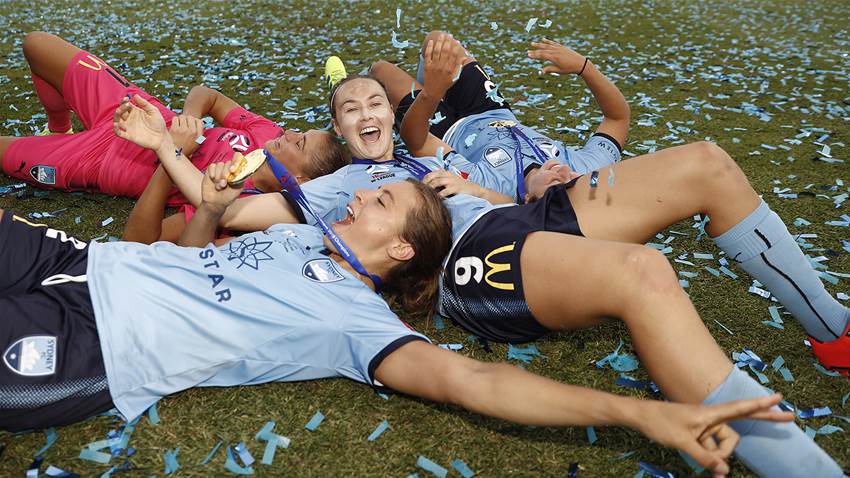Players want to work on making the W-League a "genuine world class competition" after fans' fears that it has been left behind in the wake of the split from Football Australia.
The A-League, W-League and Y-League all now come under the remit of the club-run Australian Professional Leagues since the exit from Football Australia was finalised on New Year’s Eve.
But fans fear all the APL focus is now on the A-League's struggles…and the W-League is withering on the vine in the face of increased competition around the world.
Despite Australia and New Zealand winning the rights to host the 2023 Women’s World Cup, there are still no official plans to expand the W-League from its current nine teams, or even extend the competition to a full home and away season from its current lopsided 14 rounds.
The W-League has only shrunk from 10 clubs since it was launched 13 years ago, with Central Coast Mariners dropping out and later blocked from rejoining, while a plan to add Wellington Phoenix this season was axed at the last moment in a row over player eligibility.
Meanwhile TV coverage has gone backwards from every game being broadcast by Fox Sports to now just a select few each round, with the quality of the coverage widely slammed for its amateur presentation and technical problems, despite a $40m government grant.
Now Professional Footballers Australia co-chief executive and former Matilda Kate Gill says it's critical to establish the W-League as world class - and football as the sport of choice for female athletes.
“Global trends, both within football and external to football, have had a massive impact on our sport and subsequently the W-League,” Gill said. “Between the players and the clubs, there’s a chance to create an ambitious plan to rebuild our competition.
"In particular, address the significant challenges facing the W-League - whether that’s the need to attract more revenue, build a program to retain talent or expanding the season length.
“These challenges are opportunities to reform the W-League to make it a world-class competition.
"The players want to build this in a sophisticated and collaborative way with the clubs.”
Now Gill wants to see the APL produce a plan to revitalise the competition in the face of growing competition from around the world.
“Independence gives our game the opportunity to build out our professional Leagues, delivering a W-League that is a genuine world class competition for female footballers," she said.
"There are challenges ahead, but we’re excited about that opportunity, and we’re eager to work with the clubs to deliver that.”
The growth of women’s football in Europe especially has seen an exodus of talent from the local league with Matildas now playing their club games in the UK or Europe.
Previously, Matildas split their time between the W-League and the National Women’s Soccer League in the USA, which had complementary seasons allowing players to play in both.
But the rise of Europe and increased pay means Matildas can now more often focus on one club and one season.
The switch has created new opportunities for young players to come through in the W-League, but it has cast a shadow over the role of the once-trailblazing Australian league and whether it can establish itself as a world elite league to rival the UK’s FAWSL - or simply be a development league.
For Gill though the first step has to be extending the season to be a full home and away competition for it to be considered an elite professional league.
“What the players have shared with us is that they need to play more matches," she revealed.
"The season window is shorter than other leagues that are growing rapidly, so extending it out is a priority for us to keep pace.
"More matches will help us provide more certainty and more opportunity for players.”
But she also wants to see those in charge be ambitious in how they expand the league beyond its current set up – a consideration being an alternative expansion model than that of the existing A-League structure.
The recent spate of new clubs joining the A-League all had W-League ambitions during the bidding process - but APL Leagues Commissioner Greg O’Rourke made it clear then that they were simply bidding to join the A-League alone.
Years later there are still no public plans to add more A-League clubs to the W-League.
But Gill believes the W-League can forge its own path in adding clubs.
Canberra United have been a key part of the W-League since its launch and enjoyed a long run of success despite still not having an A-League club.
Now Gill believes other non-A-League outfits could also make the step up by looking at NPLW sides to expand the league, with the ultimate goal of building clubs that add value and enhance the League.
She added: "With Canberra as an example, there could be scope to expand the League out beyond the existing clubs or work on a new model or framework for expansion.
"That’s not to say the existing A-League clubs shouldn’t prioritise their women’s programs - but future expansion could come from other areas too.”
A 2019 blueprint for the future of top tier football released by the Australian Professional Football Clubs Association - prior to them becoming the APL following unbundling - laid out a series of recommendations and pledges they planned to enact if they took charge.
It included a full home and away W-League season "as a priority" and a W-League team for every A-League club.
Today the APL said they intended to commit to those policies but admitted external factors since have had an impact on operations and on activating those ambitions.
Leagues Commissioner Greg O'Rourke added: “In 2019, more than two years before unbundling was announced, we published a blueprint for the future of the professional game in Australia laying out our ambitions for the Westfield W-League, should the reform take place that would enable us to fulfil these ambitions,"
“In the nine weeks since APL’s stewardship of the Westfield W-League was announced, we have launched two seasons simultaneously for the first time ever, staged a season successfully amid ever-changing border restrictions, seen dozens of Westfield Young Matildas play in the league this season, and set in motion the plans we laid out in 2019 for a world-class premier sporting competition.
“We have an ambitious vision for the future of the Australian Professional Leagues - the A-League and the W-League. To us, it’s not men’s football or women’s football - it’s just football.”
Related Articles

A-League clubs in peril as APL prepares to wield financial axe
.jpeg&h=172&w=306&c=1&s=1)
Belief high for Jets ahead of City ALW semi-final clash














